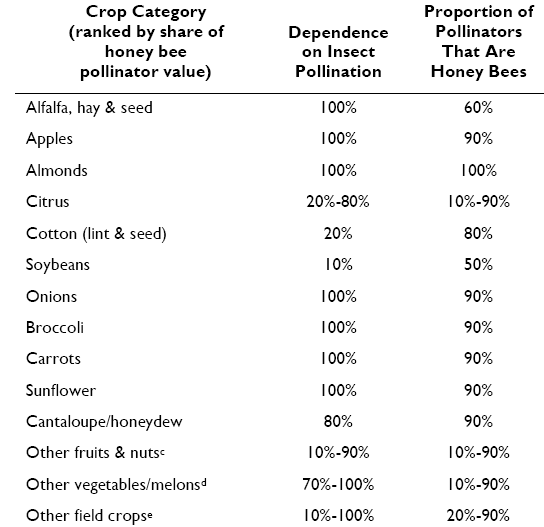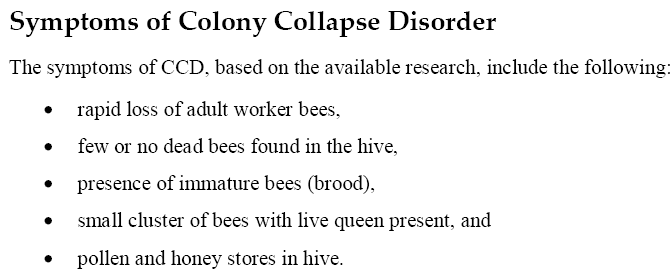
|
||||||||||||
|
|
|
Colony Collapse Disorder (CCD)
Honey bees (Apis mellifera) are the most economically valuable pollinators of agricultural crops worldwide and are the only bee species kept commercially in the United States. In the United States, bee pollination of agricultural crops is said to account for about one-third of the U.S. diet, and to contribute to the production of a wide range of high-value fruits, vegetables, tree nuts, forage crops, some field crops, and other specialty crops.
Over the past number of years, massive amounts of bees have been dying from parasites, viruses and a whole host of other ailments. But, the most impactfull has been from an unexplained syndrome known only as colony collapse disorder (or CCD), where the bees simply disappear from their hives and never return. Honey bee populations have been mysteriously falling for at least five years in the United States, but the cause of so-called colony collapse disorder (CCD) is still largely unknown. Shaded areas show reported affected states European beekeepers observed similar phenomena in Belgium, France, the Netherlands, Greece, Italy, Portugal, and Spain and initial reports have also come in from Switzerland and Germany. In the fall of 2006, a loud, new buzz began among beekeepers in a number of countries when managed honey bee colonies began to disappear in large numbers without known reason. By February 2007, the syndrome, which is characterized by the disappearance of all adult honey bees in a hive while immature bees and honey remain, had been christened “colony collapse disorder” (CCD). Some beekeepers reported losses of 30-90 percent of their hives during the 2006 winter. While colony losses are not unexpected during winter weather, the magnitude of loss suffered by these beekeepers was highly unusual. Because honey bees are critical for agricultural pollination—adding more than $15 billion in value to about 130 crops—especially high-value specialty crops like berries, nuts, fruits, and vegetables, the unexplained disappearance of so many managed colonies was not a matter to take lightly. In general, honey bee colony health has been declining since the 1980s, with the introduction of new pathogens and pests. The spread into the United States of Varroa and tracheal mites, in particular, created major new stresses on honey bees. At the same time, the call for hives to supply pollination services has continued to climb. This means honey bee colonies are trucked farther and more often than ever before, which also stresses the bees. There have been many theories about the cause of CCD, but the researchers who are leading the effort to find out why are now focused on these factors:
Additional factors may include poor nutrition, drought, and migratory stress brought about by the increased need to move bee colonies long distances to provide pollination services. The mysterious disappearance of bees, called Colony Collapse Disorder (CCD), is a growing threat to honey bees, the mainstay of pollination services in agriculture. CCD appears to be occurring across the United States. CCD is an infectious disease affecting managed European honey bees (Apis mellifera) in commercial beekeeping operations across the United States. CCD has resulted in losses of 50 to 90% of managed colonies in U.S. beekeeping operations during the past several years.
The malady was first reported in the media during the fall months of 2006, but may have been noticed by beekeepers as early as 2004, about the time when USDA-APHIS regulations were relaxed to allow for the importation of package bee colonies and queens from Australia and other countries, due to a shortage of colonies to pollinate the burgeoning California almond crop.
How CCD Differs from Past Bee Colony Losses
Current bee colony losses seem to differ from past losses in that colony losses are occurring mostly because bees are failing to return to the hive (which is largely uncharacteristic of bee behavior); bee colony losses have been rapid; colony losses are occurring in large numbers; and the reason why these losses are occurring remains still largely unknown.
The phenomenon was first called “Fall-Dwindle Disease,” but was renamed because of the unusual characteristics of the colony declines. Moreover, the condition is not only seasonal but manifests itself throughout the year. The term “dwindle” implies a gradual loss, whereas CCD onset is sudden. Also, the term “disappearance” is used to describe other types of conditions, which differ from the symptoms currently being associated with CCD. Finally, the term “disease” is usually associated with a biological agent, but none has yet been identified.
Among the key symptoms of CCD in collapsed colonies is that the adult population is suddenly gone without any accumulation of dead bees. The bees are not returning to the hive but are leaving behind their brood (young bees), their queen, and maybe a small cluster of adults. What is uncharacteristic about this situation is that the honey bee is a very social insect and colonyoriented, with a complex and organized nesting colony. Failing to return to the hive is considered highly unusual. An absence of a large number of dead bees makes an analysis of the causes of CCD difficult. Also there is little evidence that the hive may have been attacked. In actively collapsing colonies, an insufficient number of adult bees remain to care for the brood. The remaining workforce seems to be made up of young adult bees. The queen is present, appears healthy and is usually still laying eggs, but the remaining cluster is reluctant to consume feed provided by the beekeeper, and foraging is greatly reduced. Questions and Answers: Colony Collapse Disorder From The USDA Beginning in October 2006, some beekeepers began reporting losses of 30-90 percent of their hives. While colony losses are not unexpected during winter weather, the magnitude of loss suffered by some beekeepers was highly unusual. This phenomenon, which currently does not have a recognizable underlying cause, has been termed "Colony Collapse Disorder" (CCD). The main symptom of CCD is simply no or a low number of adult honey bees present but with a live queen and no dead honey bees in the hive. Often there is still honey in the hive, and immature bees (brood) are present. ARS scientists and others are in the process of carrying out research to discover the cause(s) of CCD and develop ways for beekeepers to respond to the problem. Why should the public care about honey bees? Bee pollination is responsible for $15 billion in added crop value, particularly for specialty crops such as almonds and other nuts, berries, fruits, and vegetables. About one mouthful in three in the diet directly or indirectly benefits from honey bee pollination. While there are native pollinators (honey bees came from the Old World with European colonists), honey bees are more prolific and the easiest to manage for the large scale pollination that U.S. agriculture requires. In California, the almond crop alone uses 1.3 million colonies of bees, approximately one half of all honey bees in the United States, and this need is projected to grow to 1.5 million colonies by 2010. The number of managed honey bee colonies has dropped from 5 million in the1940s to only 2.5 million today. At the same time, the call for hives to supply pollination service has continued to climb. This means honey bee colonies are trucked farther and more often than ever before. Is there currently a crisis in food production because of CCD? While CCD has created a very serious problem for beekeepers and could threaten the pollination industry if it becomes more widespread, fortunately there were enough bees to supply all the needed pollination this past spring. But we cannot wait to see if CCD becomes an agricultural crisis to do the needed research into the cause and treatment for CCD. The cost of hives for pollination has risen this year. But much of that is due to growing demand. Some of the price increase may also be due to higher cost of gas and diesel and other increases related to energy and labor costs. Commercial beekeepers truck hives long distances to provide pollination services, so in particular they must deal with rising expenses. Are there any theories about what may be causing CCD? Case studies and questionnaires related to management practices and environmental factors have identified a few common factors shared by those beekeepers experiencing CCD, but no common environmental agents or chemicals stand out as causative. There are three major possibilities that are being looked into by researchers. Pesticides may be having unexpected negative effects on honey bees. A new parasite or pathogen may be attacking honey bees. One possible candidate being looked at is a pathogenic gut microbe called Nosema. Viruses are also suspected. A perfect storm of existing stresses may have unexpectedly weakened colonies leading to collapse. Stress, in general, compromises the immune system of bees (and other social insects) and may disrupt their social system, making colonies more susceptible to disease. These stresses could include high levels of infection by the varroa mite (a parasite that feeds on bee blood and transmits bee viruses); poor nutrition due to apiary overcrowding, pollination of crops with low nutritional value, or pollen or nectar scarcity; and exposure to limited or contaminated water supplies. Migratory stress brought about by increased needs for pollination might also be a contributing factor. Has CCD ever happened before? The scientific literature has several mentions of honey bee disappearances—in the 1880s, the 1920s and the 1960s. While the descriptions sound similar to CCD, there is no way to know for sure if the problems were caused by the same agents as today's CCD. There have also been unusual colony losses before. In 1903, in the Cache Valley in Utah, 2000 colonies were lost to an unknown "disappearing disease" after a "hard winter and a cold spring." More recently, in 1995-96, Pennsylvania beekeepers lost 53 percent of their colonies without a specific identifiable cause. Credit: Texas A&M University, National Honey Board , Penn State, PBS, USDA |




